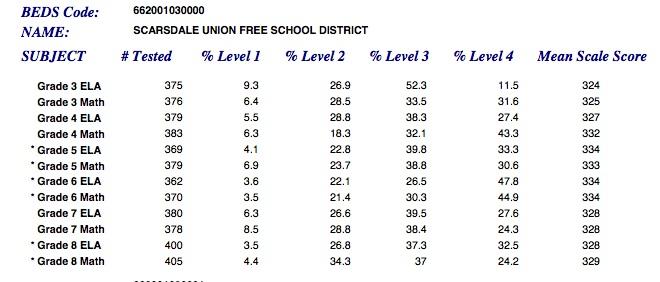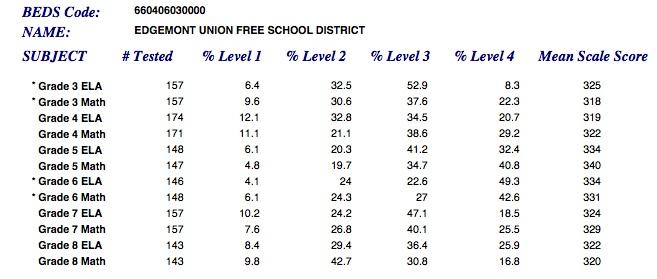Test Scores Under the Microscope: Beginning to Understand the NYS Test Results for Grades 3-8
- Category: Schools
- Published: Wednesday, 14 August 2013 08:57
 At the beginning of vacation month for many Scarsdale families, Dr. McGill, Superintendent of Schools, sent an email to district parents regarding the recently released (to the districts, not to parents) New York State (NYS) test results for grades 3-8. We have reprinted the email, which came via the Infinite Campus Messenger system, for those parents who didn't see the original email, as well as for those who do not have children enrolled in district schools.
At the beginning of vacation month for many Scarsdale families, Dr. McGill, Superintendent of Schools, sent an email to district parents regarding the recently released (to the districts, not to parents) New York State (NYS) test results for grades 3-8. We have reprinted the email, which came via the Infinite Campus Messenger system, for those parents who didn't see the original email, as well as for those who do not have children enrolled in district schools.
Dear Parents,
As you may know from recent newspaper reports, this past spring's round of state testing featured a new generation of more difficult elementary and middle school exams. As a result, the State Department of Education predicted that results would be weaker than in previous years. Officials said the decline wouldn't mean students were learning less or that they or their teachers were less effective. The standards were simply higher and harder to reach.
Locally, we began to receive score reports on Monday. We're still awaiting some information that will allow us to put the numbers in context. In a nutshell, however, and as the State predicted, the results aren't as strong as before. While the large preponderance of children continue to score in the 3-4 range, generally speaking, there are also more scores in the 2 range and some "1"s in each grade in each school. We anticipate that our overall outcomes will continue to be among the best in New York State.
A wider spread of scores is what one expects from a harder test – fewer at the top, more in the middle, some at the bottom. And in fact, that's exactly what we saw in Scarsdale before state tests displaced the more rigorous standardized exams we used in the 1990's.
Those earlier tests gave us information that helped identify individual student needs and program shortcomings. Because of security concerns, unfortunately, the State won't disclose similar information from the current tests. As a result, it'll be harder to use the results to improve instruction. For purposes of brevity, I won't explore this or other controversial aspects of the new exams here, but for those interested, will provide further information in the not-too-distant future.
The goal of the new state tests is to determine whether students are "college and career-ready." The State Education Department's method is to set annual learning targets by "scaffolding" exams, so that they build sequentially from one grade to the next. The assumption is that if students meet the targets, they'll move systematically and successfully from the elementary grades, through high school, to college or career.
In fact, most strong school districts, Scarsdale included, have long had sequential curriculums and assessments that set objectives for student growth each year. Among the difficulties with this construct: people don't learn in neat, sequential, annual increments. For example, gains often occur in spurts, in conjunction with brain development, not on a fixed schedule.
In practice, therefore, it's most realistic to evaluate children's growth in a larger context – looking at a much wider range of information than a single test score and also looking at the record over time.
Most broadly, what we know about student progress in Scarsdale is that children change and develop in many dimensions between the time they're in kindergarten and the time they're seniors. Over the full 13 years, motivated students, engaged parents and quality teaching combine to produce significant personal growth. When they leave us, 99 percent of our graduates go to college, 95 percent go to 4-year colleges and over 60 percent typically are admitted to the most selective colleges and universities in the nation.
We never want to be complacent, and we can always continue to improve. Nonetheless, the range of information we have about every Scarsdale student, as well as an established record of success, are cause for confidence. By providing our graduates a deep and powerful education all along the way, we foster able, contributing adults.
As principals and district administrators gain access to the full range of information about this year's state tests and as we have an opportunity to evaluate its significance, we may get back in touch with further thoughts. If you have questions, please share them. This being vacation season, please understand if a response is not immediate.
In the fall, and consistent with the usual practice, school principals will be in touch with elementary and middle school parents to offer more specific information about their children's performance on the spring exams. As always, there will be opportunities to discuss individual results and children's growth.
I trust that the summer months are being all you would wish and look forward to resuming our collective journey in the autumn.
Sincerely,
Michael V. McGill
Superintendent of Schools
Dr. McGill's email raises many important issues. One question that town residents are sure to ask is how test results will affect perceptions of Scarsdale schools and, possibly, property values. Will Scarsdale still retain its reputation as a town that stresses academic excellence? A visit to the New York State Department of Education (NYSED) website provides some understanding of how Scarsdale performed versus other districts across Westchester and the state. For example, Scarsdale performed significantly better in English Language Arts (ELA) than most other districts in Westchester and across New York State, even considering that the tests were redesigned and more challenging.

As stated by Dr. McGill, students' individual scores are not being released because of security concerns. What these concerns are remain unclear as procedures certainly could be implemented to protect the sensitivity of this information. Dr. McGill suggests that the amalgamation of scores by district, schools and grades limits their usefulness. More specifically, combining student scores in this way reveals nothing about how individual students have performed and whether a specific student is making adequate progress in reaching the standards developed by the NYSED. As such, parents and teachers are not able to use the test data to identify weaknesses in specific academic areas and intervene when appropriate. It should be noted, as Dr. McGill states in his email, that multiple sources of information are necessary to evaluate children's academic progress, not just a score on one test. However, the score on the state-mandated test could be one of pieces of information used to evaluate how well a student develops important skills over time. Failure to provide specific information about each student also does not allow parents, teachers and, perhaps most importantly, students, to appreciate significant improvements that are made academically over the years.

Another issue limiting the usefulness of the test scores is the apparent significant changes in the test content made to meet the "Common Core" standards. These changes reportedly increased the difficulty of the most recent tests administered over the previous ones. In support of these changes, The NYSED website states that "The new assessments are a better, more accurate tool for educators, students, and parents as they work together to address the rigorous demands of the Common Core and college and career readiness in the 21st century." However, the significant changes in the content of the test seem to severely limit its usefulness as a measurement of change from the previous state-mandated tests. As quoted on the NYSED website, Board of Regents Chancellor Merryl H. Tisch states that "These scores reflect a new baseline and a new beginning." One wonders, however, whether the content of the next series of state-mandated tests also will be modified significantly as beliefs about what constitutes the "Common Core" also change. In other words, will we face the same problem as we do now in that we may not be able to make valid comparisons between recent test scores and previous ones?
Finally, the wide-publication of state-mandated scores may result in a myopic perspective on how students in a particular district, school and grade are performing. As Dr. McGill emphasizes, there are many criteria that are necessary in evaluating the success of schools. Without a conscious awareness of other indicators of academic success, parents, teachers, students, and even prospective town residents, may not fully appreciate the high quality of education that students in towns like Scarsdale receive.










